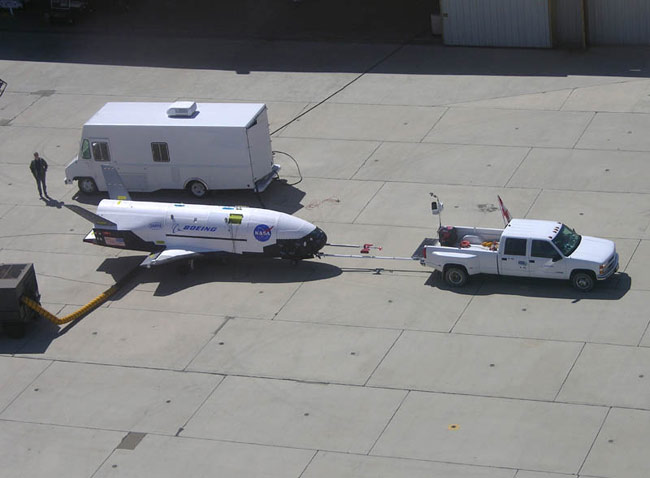White Knight Prepares For New Mission

The innovative carrier plane used to air launch SpaceShipOnehas a new mission. At the Mojave, Californiainland spaceport, the White Knight mothership has been involved in fit andhigh-speed taxi checks with a new passenger - the X-37, an unpiloted, reusablespaceplane.
TheWhite Knight/X-37 combination has undergone a set of recent ground evaluations,including high-speed taxi testing this week.
Designed by ScaledComposites of Mojave, California,the White Knight was utilized to haul SpaceShipOne to altitude and thenreleased the piloted rocketplane for its record-setting suborbital treks,including the snagging of the high-stakes $10 million Ansari X Prize last year.
In its new role, the White Knight is being readied to carry the Boeing, Defense Advanced Research Projects Agency (DARPA), NASA-supported vehicle skyward. No official word yet on when the twosome will take to the air, or what is the timeframe for the first drop test of the X-37 using the White Knight.
Technology testbed
TheX-37 has been billed as an unpiloted, autonomously operated vehicle designed toconduct on-orbit operations and collect test data in the Mach 25 (reentry)region of flight.
TheBoeing-built X-37 is geared to be a test bed for airframe, propulsion andoperation technologies designed to make space transportation and operationssignificantly more affordable.
Get the Space.com Newsletter
Breaking space news, the latest updates on rocket launches, skywatching events and more!
Accordingto a Boeing fact sheet on the craft, the X-37 project is exploring potentialnew commercial and military reusable space vehicle market applications, be theyon-orbit satellite repair to the next-generation of totally reusable launchvehicles.
Latelast year, NASA transferred its X-37 technology demonstration program to thePentagon's Defense Advanced Research Projects Agency (DARPA).
The Approach and LandingTest Vehicle (ALTV) has been at the Mojave airport since mid-April,explained Jan Walker, a DARPA spokesperson. "The first taxi test occurredearlier this month. In addition to the taxi tests, the ALTV also planscaptive carry flights and drop tests. The tests will continue through thissummer, but we've not announced any specific dates," Walker told SPACE.com.
Checkered history
NASA'sinvolvement in the X-37 dates back to 1998, when the project was selected asthe first of a planned series of flight demonstrators dubbed Future X. At thetime, NASA agreed to share the X-37's projected $173 million cost with Boeingand the U.S. Air Force. After the Air Force announced in 2001 that it wouldstop funding the project, NASA told Boeing that thecompany would have to submit a new proposal for the X-37 to be eligible foradditional funding.
Afterpersistent prodding from U.S. Rep. Dana Rohrabacher (R-Calif.), NASA in 2002awarded Boeing a $301 million contract for two X-37 vehicles instead of one.One of those vehicles would conduct a series of drop tests within theatmosphere, paving the way for the flight of the orbit and re-entry vehicle in2006.
ButNASA advised Boeing in late 2003 to throttle back on development of the orbitand re-entry vehicle and directed Boeing to stop work on that part of theprogram altogether. X-37 was dealt a further setback last year when a NASAreview concluded that the program was not a good fit with the agency's newspace exploration agenda.
Brian Berger of SpaceNews contributed to this story.
Join our Space Forums to keep talking space on the latest missions, night sky and more! And if you have a news tip, correction or comment, let us know at: community@space.com.

Leonard David is an award-winning space journalist who has been reporting on space activities for more than 50 years. Currently writing as Space.com's Space Insider Columnist among his other projects, Leonard has authored numerous books on space exploration, Mars missions and more, with his latest being "Moon Rush: The New Space Race" published in 2019 by National Geographic. He also wrote "Mars: Our Future on the Red Planet" released in 2016 by National Geographic. Leonard has served as a correspondent for SpaceNews, Scientific American and Aerospace America for the AIAA. He has received many awards, including the first Ordway Award for Sustained Excellence in Spaceflight History in 2015 at the AAS Wernher von Braun Memorial Symposium. You can find out Leonard's latest project at his website and on Twitter.









